‘Armed protesters’ reportedly try to overrun military bases and police stations, are repelled by security forces; 450 said arrested over 3 days of demonstrations in Tehran
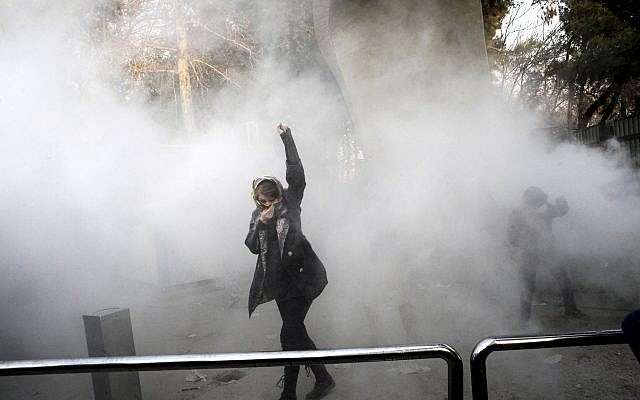
Iranian state television reported Tuesday morning that nine people had been killed overnight, among them a young boy, amid nationwide protests and unrest. The report raised the death toll in six days of demonstrations to at least 20 people.
State TV said six rioters were killed during an attack on a police station in the town of Qahdarijan. It reported that clashes were sparked by rioters who tried to steal guns from the police station. The report said an 11-year-old boy and a 20-year-old man were killed in the town of Khomeinishahr, while a member of Iran’s paramilitary Revolutionary Guard was killed in the town of Najafabad. All were reportedly shot by hunting rifles.
The towns are all in Iran’s central Isfahan province, some 350 kilometers (215 miles) south of Tehran.
It wasn’t clear if the Revolutionary Guard member was the same fatality reported in Najafabad late Monday night by Iran’s semi-official Mehr news agency.
Also on Tuesday, a semi-official news agency in Iran reported that 450 people had been arrested over three days in Tehran since Saturday. The ILNA news agency report quoted Ali Asghar Nasserbakht, a security deputy governor of Tehran, offering the figure. Nasserbakht said that 200 protesters were arrested on Saturday, 150 on Sunday and 100 were arrested Monday.
The demonstrations, the largest to strike Iran since its disputed 2009 presidential election, have seen five days of unrest across the country and a death toll of at least 13 with the slaying of a police officer announced late Monday.
The protests began Thursday in Mashhad over Iran’s weak economy and a jump in food prices and have expanded to several cities, with some protesters chanting against the government and the supreme leader, Ayatollah Ali Khamenei. Hundreds of people have been arrested.
Iranian state television aired footage of a ransacked private bank, broken windows, overturned cars and a firetruck that appeared to have been set ablaze. It said 10 people were killed by security forces during clashes Sunday night.
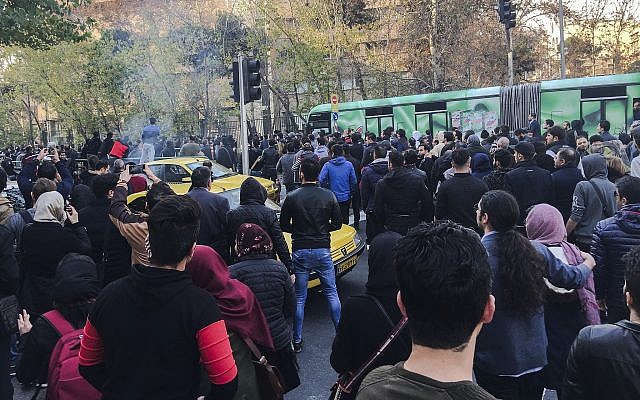
“Some armed protesters tried to take over some police stations and military bases but faced serious resistance from security forces,” state TV said.
In a later report, state TV said six people were killed in the western town of Tuyserkan, 295 kilometers (185 miles) southwest of Tehran, and three in the town of Shahinshahr, 315 kilometers (195 miles) south of Tehran. It did not say where the 10th person was killed.
Earlier Monday, the semi-official ILNA news agency quoted Hedayatollah Khademi, a representative for the town of Izeh, as saying two people died there Sunday night. He said the cause of death wasn’t immediately known, though authorities later described one of the deaths as the result of a personal dispute.
Late Monday, Iran’s semi-official Mehr news agency said an assailant using a hunting rifle killed a policeman and wounded three other officers during a demonstration in Najafabad. The slaying marked the first security force member to be killed in the unrest.
Two protesters also were killed during clashes late Saturday in Doroud, some 325 kilometers (200 miles) southwest of Tehran in Lorestan province, authorities have said.
On Sunday, Iran blocked access to Instagram and the popular messaging app Telegram used by activists to organize.
Iran’s President Hassan Rouhani acknowledged the public’s anger over the Islamic Republic’s flagging economy, though he and others warned that the government wouldn’t hesitate to crack down on those it considers lawbreakers.
That was echoed Monday by judiciary chief Ayatollah Sadegh Larijani, who urged authorities to confront rioters, state TV reported.
“I demand all prosecutors across the country to get involved and the approach should be strong,” he said.
Rouhani also stressed Monday that Iran “has seen many similar events and passed them easily.”
The head of Tehran’s Revolutionary Court, which handles cases involving alleged attempts to overthrow the government, warned that arrested protesters could potentially face the death penalty in cases that come to trial.
Iran’s semi-official Tasnim news agency quoted Mousa Ghazanfarabadi on Tuesday as saying, “Obviously one of their charges can be Moharebeh,” or waging war against God. That’s a death penalty offense in Iran.
Ghazanfarabadi also was quoted as saying some protesters will come to trial soon on charges of acting against national security and damaging public properties. He also stressed that attending rallies not sanctioned by Iran’s Interior Ministry, which oversees police, was illegal.
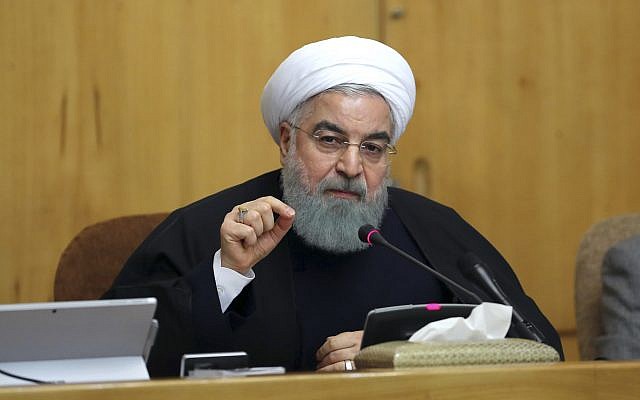
US President Donald Trump, who has been tweeting in support of the protesters, continued into the New Year, describing Iran as “failing at every level despite the terrible deal made with them by the Obama Administration.”
“The great Iranian people have been repressed for many years,” he wrote. “They are hungry for food & for freedom. Along with human rights, the wealth of Iran is being looted. TIME FOR CHANGE!”
While some have shared Trump’s tweets, many in Iran distrust him because he has refused to re-certify the nuclear deal and his travel bans have blocked Iranians from getting US visas.
In Israel, Prime Minister Benjamin Netanyahu, calling the protesters “brave” and “heroic,” said in a video posted to YouTube on Monday that the protesters sought freedom, justice and “the basic liberties that have been denied to them for decades.”
He criticized the Iranian regime’s response to the protests and also chided European governments for watching “in silence” as the protests turn violent.
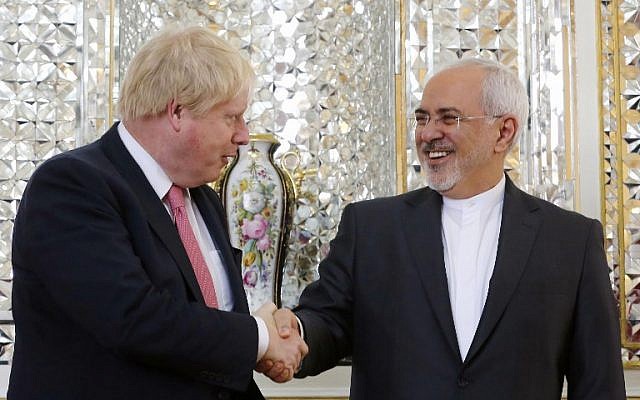
British Foreign Secretary Boris Johnson issued a statement late Monday saying “there should be meaningful debate about the legitimate and important issues the protesters are raising and we look to the Iranian authorities to permit this.”
“We regret the loss of life that has occurred in the protests in Iran, and call on all concerned to refrain from violence and for international obligations on human rights to be observed,” he said.
German Foreign Minister Sigmar Gabriel also said in a statement that “after the confrontation of the past days it is all the more important for all sides to refrain from violent action.” Both countries were part of the 2015 nuclear deal.
Iran’s economy has improved since the nuclear deal, which saw Iran agree to limit its enrichment of uranium in exchange for the end of some international sanctions. Tehran now sells its oil on the global market and has signed deals to purchase tens of billions of dollars’ worth of Western aircraft.
That improvement has not reached the average Iranian, however. Unemployment remains high, and official inflation has crept up to 10 percent again. A recent increase in egg and poultry prices by as much as 40 percent, which the government has blamed on a cull over avian flu fears, appears to have been the spark for the economic protests.
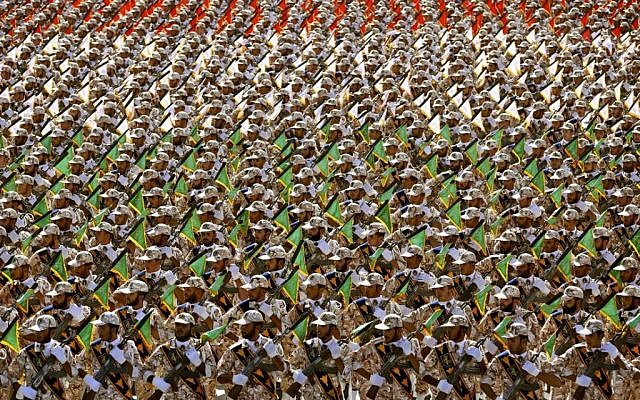
While the protests have sparked clashes, Iran’s paramilitary Revolutionary Guard and its affiliates have not intervened as they have in other unauthorized demonstrations since the 2009 election.
It wasn’t immediately clear if the Guard would change its posture given the reported attacks on police stations and military bases. In Tehran on Monday, streets were calm, though a heavy police presence was noticeable.
Brig. Gen. Massoud Jazayeri , the Guard commander and deputy chief of staff for Iran’s military, said Monday that Trump’s support of the protesters “indicates planning by the US for launching a new sedition in Iran.”



Leave a Reply
You must be logged in to post a comment.